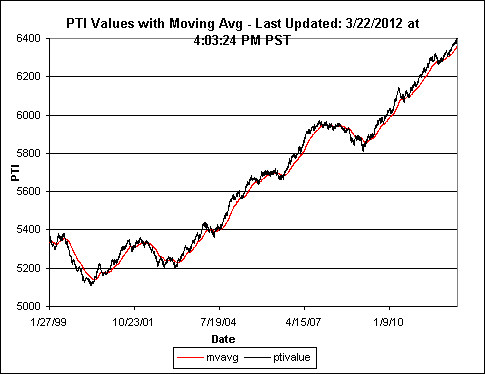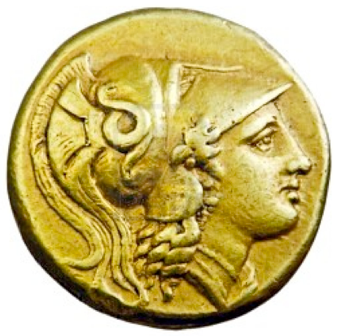Gold & Precious Metals


March 22, 2012 – Russell turns chicken — The retail public usually buys stocks during the opening hours of the session. The pros and the institutions usually do their trading during the waning hours of the session. With today’s market action I took a small profit and sold out my DIAs, yes against the dictates of my PTI. I just didn’t feel that the risk-to-reward was worth sitting with stocks at this juncture. I’m waiting to see the days when the market firms up near the close, which is the opposite of what it’s been doing. I don’t like markets that tend to sell off during the last two hours of trading. I’m now satisfied to be on the sidelines with zero common stocks. I’ll just watch the action for a while. My inclination and feeling — neutral, very neutral. But no sell signal yet from my PTI.

Earlier in the Day Russell Wrote:
The fact is that the Fed is happy with 2% inflation each and every year. Compound 2% inflation year after year, and you know what’s happening? — you’ve effectively wiped out the middle class. Between inflation, stagnant wages, higher taxes, and no jobs, the middle class has hit the brick wall like a fresh egg hitting the trunk of a redwood tree. Whoosh!
The Dow appears to waffle around during the length of each trading day and then at the close the Dow is down 10 to 50 points. What is this? Reverse inflation? Or is the Dow trying to tell us something? Honest, I don’t know what!
Personally, I don’t care for the action, but my PTI still says “bullish.” Most of us are so tired of hearing about Greece that we wish the country would just sink into the Mediterranean and take Portugal and Spain with it.
About Richard Russell (scroll down for his offer for a two week $1.00 “free” trial)
Russell began publishing Dow Theory Letters in 1958, and he has been writing the Letters ever since (never once having skipped a Letter). Dow Theory Letters is the oldest service continuously written by one person in the business.
Russell gained wide recognition via a series of over 30 Dow Theory and technical articles that he wrote for Barron’s during the late-’50s through the ’90s. Through Barron’s and via word of mouth, he gained a wide following. Russell was the first (in 1960) to recommend gold stocks. He called the top of the 1949-’66 bull market. And almost to the day he called the bottom of the great 1972-’74 bear market, and the beginning of the great bull market which started in December 1974.
The Letters, published every three weeks, cover the US stock market, foreign markets, bonds, precious metals, commodities, economics –plus Russell’s widely-followed comments and observations and stock market philosophy.
In 1989 Russell took over Julian Snyder’s well-known advisory service, “International Moneyline”, a service which Mr. Synder ran from Switzerland. Then, in 1998 Russell took over the Zweig Forecast from famed market analyst, Martin Zweig. Russell has written articles and been quoted in such publications as Bloomberg magazine, Barron’s, Time, Newsweek, Money Magazine, the Wall Street Journal, the New York Times, Reuters, and others. Subscribers to Dow Theory Letters number over 12,000, hailing from all 50 states and dozens of overseas counties.
A native New Yorker (born in 1924) Russell has lived through depressions and booms, through good times and bad, through war and peace. He was educated at Rutgers and received his BA at NYU. Russell flew as a combat bombardier on B-25 Mitchell Bombers with the 12th Air Force during World War II.
One of the favorite features of the Letter is Russell’s daily Primary Trend Index (PTI), which is a proprietary index which has been included in the Letters since 1971. The PTI has been an amazingly accurate and useful guide to the trend of the market, and it often actually differs with Russell’s opinions. But Russell always defers to his PTI. Says Russell, “The PTI is a lot smarter than I am. It’s a great ego-deflator, as far as I’m concerned, and I’ve learned never to fight it.”
Letters are published and mailed every three weeks. We offer a TRIAL (two consecutive up-to-date issues) for $1.00 (same price that was originally charged in 1958). Trials, please one time only. Mail your $1.00 check to: Dow Theory Letters, PO Box 1759, La Jolla, CA 92038 (annual cost of a subscription is $300, tax deductible if ordered through your business).
IMPORTANT: As an added plus for subscribers, the latest Primary Trend Index (PTI) figure for the day will be posted on our web site — posting will take place a few hours after the close of the market. Also included will be Russell’s comments and observations on the day’s action along with critical market data. Each subscriber will be issued a private user name and password for entrance to the members area of the website.
Investors Intelligence is the organization that monitors almost ALL market letters and then releases their widely-followed “percentage of bullish or bearish advisory services.” This is what Investors Intelligence says about Richard Russell’s Dow Theory Letters: “Richard Russell is by far the most interesting writer of all the services we get.” Feb. 19, 1999.
Below are two of the most widely read articles published by Dow Theory Letters over the past 40 years. Request for these pieces have been received from dozens of organizations. Click on the titles to read the articles.


Oil as a commodity has always been a highly valuable early warning indicator of economic instability. “The most prominent but false conclusions on the expanding value of oil are centered on assertions that supply is decreasing dramatically, while demand is increasing dramatically. Neither of these claims is true…“


With continued volatility in gold, silver, oil and stocks, today King World News interviewed Peter Schiff, CEO of Europacific Capital. Schiff told KWN it’s inflation that is causing the move in stocks. He also discussed gold and the mining shares, but first, here is what Schiff had to say about oil and the situation in Iran: “I hope we don’t get involved in Iran. Anytime we get more involved in the Middle-East we create more problems. Maybe the administration is looking for something to blame the high oil price on, rather than admit it’s excess money printing causing the problem.”













